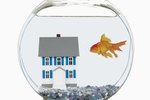Cramming fish into too small of a tank is akin to a cramped house party that may seem colorful and fun at first but just goes downhill from there. Fish without enough room to grow, move and thrive are susceptible to a host of problems that can cut their lives short. When in doubt about tank size, always err on the side of surplus gallons. Run your stocking through an aquarium calculator to ensure you have enough room and filtration for the species in your tank.
Shortened Life Span
If you've ever heard that a fish will grow only as big as his enclosure, know that it's not a good thing. A juvenile fish growing up in a too-small tank can be expected to experience stunted growth, spinal deformities, atrophied muscles and other developmental heath problems. As a result, a stunted fish's life span is significantly shortened, too.
Tips
If you've purchased a fish that you know will outgrow your tank, return or rehome him while he's still a juvenile. Once health problems have developed from cramped quarters, it will be harder to find him an adequate home.
Fighting for Space
Imagine if you had to share one room with another person for your entire life. It might be fun being roomies for a while, but then their constant, in-your-face presence will start to grate on your nerves. You just want this person out of your territory for a bit, and tempers rise. This is what happens when multiple fish, especially territorial species, are forced to coexist in a small space.
You need a tank large enough for fish to have their own hiding places and corners to just get away from ornery tank mates if needed. If not, expect to see aggression that may not otherwise happen in a tank with enough room.
Tips
Make sure not only that you have enough room for fish as they grow, but that your species are compatible. Let your local fish store expert know exactly what's inhabiting your tank before buying a new addition.
Poor Water Quality
The nitrogen cycle is critical to a healthy aquarium. Fish expel waste, which in turn creates ammonia. Bacteria converts ammonia to nitrite, which is in turn converted to less-toxic nitrate in a fully cycled aquarium.
Cramping fish into small quarters can wreak havoc on water quality unless frequent partial water changes and gravel vacuuming can keep up with the waste bioload. Overfeeding or adding too many new fish at one time only exacerbates the problem. Poor water quality leads to fish deaths.
Warnings
No matter the size of your aquarium, test water regularly to ensure all levels are within healthy ranges. Ammonia and nitrite should be at zero.
Stress and Illness
Think of your home, then think of living all the time in just one room of the house. You'd get stressed and acquire a serious case of cabin fever. Fish that by nature would get a pond, river or ocean as their habitat need room to move. Think of how differently a betta in a 20-gallon tank acts compared to one sitting in a little cup at the pet store. The former is happily exploring his environment, spreading his fins and getting exercise, while the latter is merely existing.
A healthy fish that is happy and relaxed in its environment is better equipped to fight off disease. Signs of stress include skin or behavioral abnormalities, parasitic or fungal infections, indifference to food and gulping air at the surface of the water to get extra oxygen.




